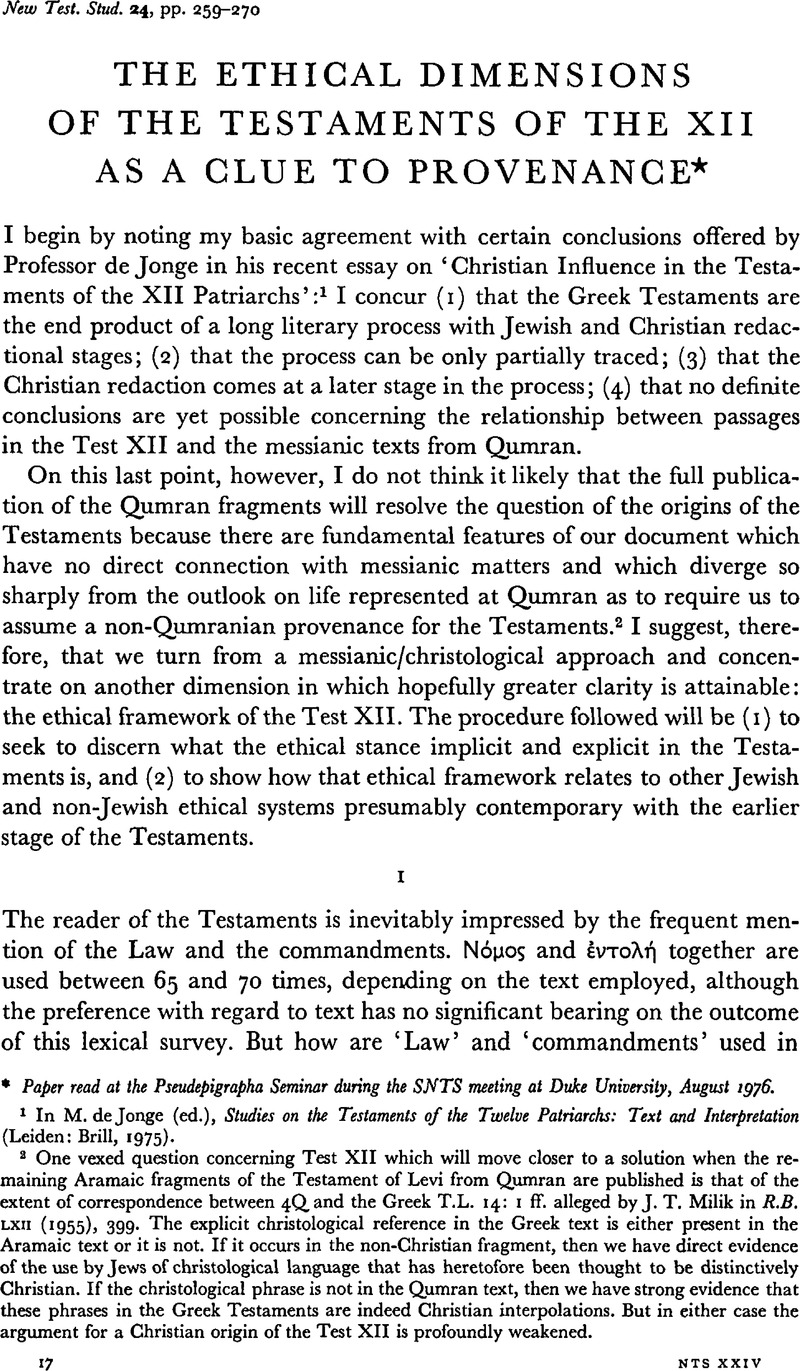Article contents
The Ethical Dimensions of the Testaments of the XII as a Clue to Provenance*
Published online by Cambridge University Press: 05 February 2009
Abstract

- Type
- Short Studies
- Information
- Copyright
- Copyright © Cambridge University Press 1978
References
page 259 note 1 In Jonge, M. de (ed.), Studies on the Testaments of the Twelve Patriarchs: Text and Interpretation (Leiden: Brill, 1975).Google Scholar
page 259 note 2 One vexed question concerning Test XII which will move closer to a solution when the remaining Aramaic fragments of the Testament of Levi from Qumran are published is that of the extent of correspondence between 4Q and the Greek T.L. 14: I if. alleged by Milik, J. T. in R.B. 62 (1955), 399Google Scholar. The explicit christological reference in the Greek text is either present in the Aramaic text or it is not. If it occurs in the non-Christian fragment, then we have direct evidence of the use by Jews of christological language that has heretofore been thought to be distinctively Christian. If the christological phrase is not in the Qumran text, then we have strong evidence that these phrases in the Greek Testaments are indeed Christian interpolations. But in either case the argument for a Christian origin of the Test XII is profoundly weakened.
page 262 note 1 IV Macc. i. 20, V. 7, 8, 25, xiii. 27, XV. 13, 25, xvi. 3.
page 263 note 1 Reading μίτραν το![]() σημείου (in De Jonge's text).
σημείου (in De Jonge's text).
page 264 note 1 Cf. Amstutz, Joseph, АΠΛΟΤΗΣ: Eine begriffsgeschichtliche Studie zum jüdisch-christlichen Griechisch (Bonn: Hanstein, 1968)Google Scholar. Amstutz offers a useful philological survey of the term, but his suggestion of a probable parallel development of άπλότης among Greek-speaking Jews and of ![]() as an ideal at Qumran (pp. 92 f.) is wholly unconvincing, since at Qumran the twin goals are conformity to the Law and the regulations of the community – both of which are wholly missing from Test XII.
as an ideal at Qumran (pp. 92 f.) is wholly unconvincing, since at Qumran the twin goals are conformity to the Law and the regulations of the community – both of which are wholly missing from Test XII.
page 264 note 2 Charles, R. H., The Testaments of the Twelve Patriarchs, (London: S.P.C.K., 1917), p. 9.Google Scholar
page 264 note 3 So Kidd, I. G., ‘Posidonius on Emotions’, in Problems in Stoicism (London, 1971), ed. Long, A. A.Google Scholar. Quoted by Long, A. A., Hellenistic Philosophy (London: Duckworth, 1974), p. 219.Google Scholar
page 264 note 4 Hengel, M., Judaism and Hellenism, 1, 229–30Google Scholar; II, 153 n. 776.
page 264 note 5 Following the translation of Gaster, T. H., IQS 3, The Dead Sea Scriptures2 (New York: Double-day, 1964), p. 50Google Scholar. 1 M. de Jonge has characterized T.I. as ‘typisch’ in ‘Testament Issachar als “Typisches” Testament’, Studies (Leiden: Brill, 1975), pp. 291–316.Google Scholar
page 265 note 1 Long, A. A., Hellenistic Philosophy, p. 171.Google Scholar
page 266 note 1 Cicero, , De officiis 1.31, 79.Google Scholar
page 267 note 1 On the Christian interpolations, which are approximately twelve in number, and which occur in messianic passages rather than in ethical sections, see below, p. 268, n. 1.
page 267 note 2 Cicero, , De divinatione, 1. 129Google Scholar; 2.47.
page 267 note 3 Panaetii Rhodii Fragmenta (Leiden, 1962), fr. 64–9.Google Scholar
page 267 note 4 My list includes T.D. 6:8 (?); T.S. 6:5, 7; 7:2; T.N. 8:3; T.Jos. 19:8 (A); T.Z. 9:8; T.L. 4:4; 10:2; 14:2; 18:7. T.L. 4:4 is an excellent example of Christian transformation by simple addition of a few phrases.
page 268 note 1 Jonge, M. de, ‘Christian Elements’, pp. 208–9.Google Scholar
page 268 note 2 Cf. for example, the Testament of Job, with its strong element of Merkebah mysticism.
- 6
- Cited by


